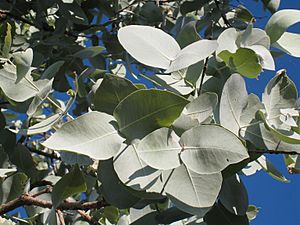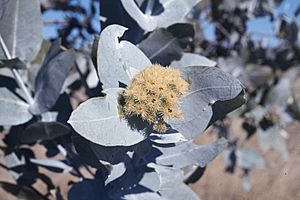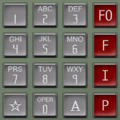Silver box facts for kids
Quick facts for kids Silver box |
|
|---|---|
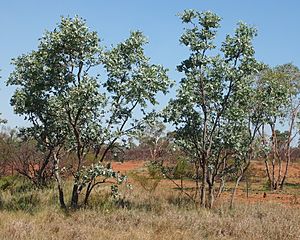 |
|
| E. pruinosa habit | |
| Scientific classification | |
| Genus: |
Eucalyptus
|
| Species: |
pruinosa
|
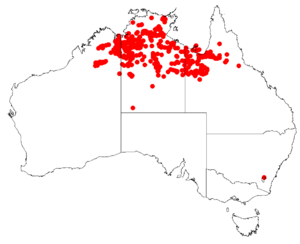 |
|
| Occurrence data from AVH | |
| Synonyms | |
|
Eucalyptus spodophylla F.Muell. |
|
The Eucalyptus pruinosa, also known as silver box or silver leaf box, is a special kind of tree or mallee. It grows only in northern Australia. People from the Jaminjung group call it yarrirra or jarnbiny. The Jaru and Wagiman people call it wararn.
This plant has rough bark on its trunk and branches. Its top part, called the crown, has young, silvery-blue leaves. These leaves are shaped like hearts or ovals and grow in pairs. The tree also has flower buds that grow in groups of seven. Its flowers are creamy white or pale yellow. Later, it grows fruit that looks like a cylinder or cone.
Contents
What Does the Silver Box Look Like?
The Eucalyptus pruinosa is a tree or a mallee. It usually grows to be about 2 to 7 meters (6 to 23 feet) tall. It has a special woody swelling at its base called a lignotuber. This helps it regrow after fires.
Its bark is grey, rough, and can be flaky or cracked. Young plants have stems that are silvery-blue and have wings. The leaves at the top of the tree are also silvery-blue on both sides. They are heart-shaped or oval and grow directly on the stem without a stalk. These leaves are about 90 to 140 mm (3.5 to 5.5 inches) long and 35 to 105 mm (1.4 to 4.1 inches) wide.
The flower buds grow in groups of seven at the ends of the branches. They are on a thick stalk called a peduncle, which is 3 to 26 mm (0.1 to 1 inch) long. Each bud has its own small stalk, called a pedicel, which is 2 to 12 mm (0.1 to 0.5 inches) long.
Mature buds can be spindle-shaped, oval, or pear-shaped. They are 6 to 12 mm (0.2 to 0.5 inches) long and 3 to 4 mm (0.1 to 0.2 inches) wide. They have a cone-shaped or beaked cap called an operculum.
Flowers and Fruit
The silver box flowers bloom from March to October. Their flowers are creamy white or pale yellow.
After flowering, the tree produces woody fruit. This fruit is a capsule that looks like a cylinder or cone. It is 5 to 11 mm (0.2 to 0.4 inches) long and 5 to 8 mm (0.2 to 0.3 inches) wide. The seeds inside are flat or oval and blackish.
How Was Silver Box Named?
The Eucalyptus pruinosa was first officially described in 1843. This was done by a scientist named Johannes Conrad Schauer. He wrote about it in a book called Repertorium Botanices Systematicae.
The first sample of this plant was collected in 1802. It was found by Robert Brown and Ferdinand Bauer. They found it on the South Wellesley Islands near Queensland.
The name pruinosa comes from a Latin word, pruina. This word means "covered in hoar-frost." It refers to the waxy, silvery coating on the leaves and flowers of the plant.
In 2000, two other scientists, Lawrie Johnson and Ken Hill, described two types of Eucalyptus pruinosa:
- Eucalyptus pruinosa subsp. pruinosa
- Eucalyptus pruinosa subsp. tenuata: This type has smaller buds and fruit. Its small stalks are also thinner than the other type.
Where Does Silver Box Grow?
The silver box tree grows in open savannah woodlands. These are areas with scattered trees and lots of grass. It likes to grow on low limestone hills and flat areas. It grows best in sandy soils.
You can find it across northern Australia. It grows from the Kimberley region in Western Australia all the way to north-western Queensland.
In Western Australia, it is found east of the King Leopold Ranges. This includes the Shire of Halls Creek and Shire of Wyndham-East Kimberley areas.
In the Northern Territory, it grows from Katharine to near Tennant Creek. This includes the Victoria Daly and Roper Gulf Regions, and Arnhem Land.
In Queensland, you can find it as far east as Forsayth and Einasleigh. It also grows as far south as Dajarra.
Is Silver Box Protected?
This type of eucalypt is not considered to be in danger. The Western Australian Government's Department of Parks and Wildlife says it is "not threatened."
The Northern Territory Government also lists it as "least concern." This is under their Territory Parks and Wildlife Conservation Act 2000. The Queensland Government also lists it as "least concern" under their Nature Conservation Act 1992. This means there are no major worries about it disappearing.
Images for kids


